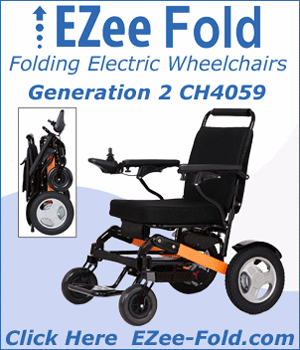Folding Versus Non-Folding Wheelchairs
What's the difference?
Wheelchairs that have an "X" frame design fold from side to side and are considered folding wheelchairs. An "X" frame is basically the cross-frame members that can be seen when looking under the seat from either the front or back of the wheelchair.
Wheelchairs known as rigid framed will not fold from side to side and are in the non-folding group of wheelchairs. In the wheelchair industry rigid wheelchairs are usually considered wheelchairs that athletes and young sports minded users would only be interested in but other can benefit from these wheelchairs as well.
Tilting wheelchairs are rigid wheelchairs and technically fit into the non-folding category but people who need a tilting wheelchair aren't the same type of user as those who able to choose between the two styles. So for the purposes of this article they will not apply.
Benefits of Folding
Folding wheelchairs are designed for the benefit of caregivers more than that of the user.
- They fold into a narrow (10" to 12") package when not in use they are easily stored away or transported in vehicles.
- They tend to be less expensive.
- They usually are easier to fit complex seating systems on.
Benefits of Non-Folding (Rigid)
Rigid wheelchairs are designed for user efficiency.
- They are lighter than folding wheelchair because their frames have less metal in them.
- Their frames don't flex when the user propels the wheelchair. If the frame flexes, part of the effort the user puts into propelling the wheelchair will actually be exerted on flexing the frame rather than moving the wheelchair.
- They are more responsive because of their more solid frames.
- They usually have folding backs to make them easier to store and transport. The rigid chair actually folds into a smaller boxlike shape as opposed to the tall narrow shape of a folding wheelchair.
- They usually have quick release axles that allow for the easy removal of the rear wheels to reduce the size and weight when transporting.
- They can be configured to better fit the user with a vast range of seat widths, seat depths, seat heights, seat angle, back heights, back angle and wheel position.
- They are simpler with fewer parts to wear out.
- Center of gravity can normally be adjusted.
Candidates for Folding Wheelchairs
- People who have plenty of strength for propelling their wheelchair
- People who need complex seating products
- People who are likely to be pushed by a caregiver fairly often
- People who need to load their wheelchair into a car trunk frequently
- People who only use a wheelchair sporadically for outings
Candidates for Non-Folding Wheelchairs
- Teens and young adults who are very active
- Children who have strength limitations but want to self-propel
- Seniors who have strength limitations but want to self-propel
- People who can manage with simple seating systems
- Basically people who want to be independent and have the most efficient wheelchair possible are better off with a rigid wheelchair as long as they do not require a complex seating system.


 Online Vendors
Online Vendors  US Online Vendors
US Online Vendors 
